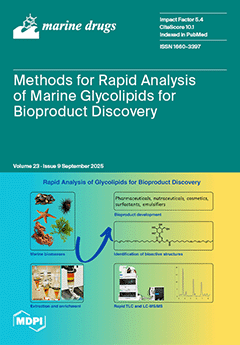The aim of this study was to investigate the metabolites in
Aspergillus subramanianii 1901NT-1.40.2 extract using UPLC-MS, isolate and elucidate the structure of individual compounds, and study the antimicrobial and cytotoxic activities of the isolated compounds. The structures of two previously unreported ergostane triterpenoid aspersubrin A (
1) and pyrazine alkaloid ochramide E (
2) were established using NMR and HR ESI-MS. The absolute configuration of
1 was determined using quantum chemical calculations. Moreover, the known polyketides sclerolide (
3) and sclerin (
4); the indolediterpene alkaloid 10,23-dihydro-24,25-dehydroaflavinine (
5); the bis-indolyl benzenoid alkaloids kumbicin D (
6), asterriquinol D dimethyl ether (
7), petromurin C (
8); and the cyclopentenedione asterredione (
9) were isolated. The effects of compounds
3-
9 on the growth and biofilm formation of the yeast-like fungus
Candida albicans and the bacteria
Staphylococcus aureus and
Escherichia coli were investigated. Compounds
5 and
6 inhibited
C. albicans growth and biofilm formation at an IC
50 of 7–10 µM. Moreover, the effects of compounds
3-
9 on non-cancerous H9c2 cardiomyocytes, HaCaT keratinocytes, MCF-10A breast epithelial cells, and breast cancer MCF-7 and MDA-MB-231 cells were also investigated. Compound
8 (10 µM) significantly decreased the viability of MCF-7 cells, inhibited colony formation, and arrested cell cycle progression and proliferation in monolayer culture. Moreover,
8 significantly decreased the area of MCF-7 3D spheroids by approximately 30%. A competitive test with 4-hydroxytamoxyfen and molecular docking showed that estrogen receptors (ERβ more than ERα) were involved in the anticancer effect of petromurin C (
8).
Full article






